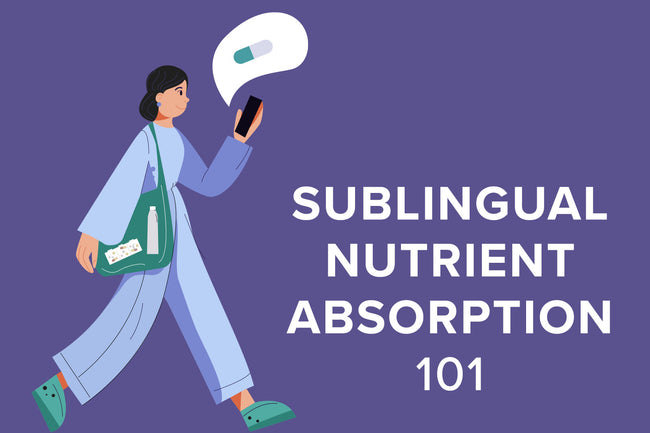
Sublingual Nutrient Absorption
Contents
- What is Sublingual Nutrient Absorption?
- How does the body digest nutrients?
- Advantages and Disadvantages of sublingual nutrient absorption
- Who takes sublingual nutrients?
- Is sublingual nutrient absorption effective?
What is Sublingual Nutrient Absorption?
Sublingual nutrient absorption is when a nutrient is absorbed under the tongue and directly enters the bloodstream rather than passing through the gastrointestinal tract. Sublingual means ‘situated or applied under the tongue’.[1] Sublingual drug administration is generally applied in the field of cardiovascular drugs, steroids and enzymes and both, sublingual drugs and nutrients, are believed to be more effective than oral ones. This is because when we take them orally, the digestive system is forced to work harder to digest them. This can lead to the stomach breaking down the vitamins before they make it into the liver (for filtration) before the bloodstream.
How does the body digest nutrients?
The small intestine's muscles combine food with digestive juices from the pancreas, liver, and intestine to push the mixture forward to help break down food. The walls of the small intestine absorb the digested nutrients into the bloodstream and the blood delivers the nutrients to the rest of the body.
Digestion
Digestion is one of the most important functions of the body providing us with nutrients from food and drink to stay healthy. Nerves, hormones, bacteria, blood, and digestive organs all work together to digest the foods and liquids we consume each day. The digestive system breaks down nutrients into particles small enough for the body to absorb, using it for energy, growth and cell repair. It breaks up protein into amino acids, fats into fatty acids and glycerol, and carbohydrates in sugars.
The pancreas produces digestive juice that contains enzymes that break down carbohydrates, fats, and proteins before delivering them to the small intestine.
The small intestine performs the majority of the digestive process by absorbing the majority of the nutrients from foods into the bloodstream. The muscles mix the food with digestive juices form the pancreas, liver and intestine to push forward for digestion.
Then, the large intestine absorbs water, minerals and any remaining nutrients from your food, changing the waste from liquid into stool.
The rectum, the lower end of your large intestine, then stores stool until it is excreted during a bowel movement.
How are sublingual nutrients digested?
Sublingual vitamins and minerals are typically a fraction of the size of traditional supplements and dissolve beneath the tongue. The mouth is lined with a mucous membrane that is protected by squamous epithelium and contains mucous glands. Sublingual glands, also known as salivary glands, are located in the floor of the mouth beneath the tongue. These glands produce mucin, which helps in the production of saliva.[2] The sublingual nutrients are absorbed by the mucosal membranes that line the mouth and are absorbed directly into the bloodstream, instead of going through the stomach and liver. When a nutrient is absorbed, a process known as osmosis occurs whereby the nutrient travels across the buccal mucous membranes by the process of diffusion.[3]
Osmosis
Osmosis refers to the movement of water molecules. When considering how sublingual nutrients work, a nutrient must be able to cross the buccal mucous membranes in order to be absorbed sublingually. This diffusion process is known as osmosis, and it applies to all types of absorption by the body – intestinal and sublingual.
Why is underneath the tongue the best place for nutrient absorption?
The area underneath the tongue has a lot of capillaries, or tiny blood vessels. This means that drugs can be absorbed directly into the bloodstream, as opposed to going through the digestive system first.
Advantages and Disadvantages of sublingual nutrient absorption
There are multiple advantages and disadvantages to sublingual nutrient absorption but a lot of it is based on preferability.
Advantages
As these nutrients do not go through the digestive system, they are not metabolised through your liver. This means that you can take less and still get the same results, if medically advised. They are also a lot easier to take for people that struggle to swallow pills and supplements as you only have to place it underneath the tongue for it to be fully absorbed.
Oral vitamins
Sublingual nutrients are also often believed to be better than oral vitamins. This is because when you take an oral vitamin, less than ten percent of the nutrient is usually absorbed in the blood stream, - crazy, right? Because the stomach breaks it down so quickly, vitamins are usually made with strong cases and shellacs to protect the pills from stomach acids. However, although the shiny coating might make it easier to swallow, it also makes it harder for your body to digest it. Oral tablets also often have added sweetener to make them more palatable, but this can block the vitamin from being absorbed into the bloodstream, which makes it difficult for the body to absorb it.
Unlike most oral tablets or pills, sublingual nutrients are also free of additives. They are the purest form of the vitamin that you are supplementing.
They are also very beneficial for medics during an emergency as they dissolve immediately and easily.
Here’s a summary of the advantages:
- Smaller tablets that are dissolvable
- Fast absorption
- No synthetic ingredients
- Easy and convenient
- Proving you optimum benefits within safe guidelines, taking less to get the same results.
Disadvantages
There seems to be little disadvantages to sublingual nutrients besides the fact that they don’t have added sugar or ingredients to make them taste nice, making them less palatable. You might find that some sublingual nutrients have a slightly sour taste to them.
It is important to be aware that eating, drinking, and smoking can all have an impact on how nutrients are absorbed and how well they work. You may also find that sublingual nutrients irritate any open mouth sores.
While they may not taste nice, they are supplementing a pure form of the nutrient – instead of additives and fillers that our bodies don’t need!
Here’s a summary of the disadvantages:
- May leave a strange/sour after tasting due to the lack of additives and synthetic ingredients to make them taste nice.
- Efficiency may be impacted by eating, drinking and alcohol.
- May irritate mouth sores.
Who takes sublingual nutrients?
Digestive problems
While anyone can take sublingual nutrients, they are particularly good for sufferers with gastro-intestinal problems like stomach ulcers, hyperactive gut or coeliac disease.[4] This is because sublingual nutrients avoid exposure to gastric systems and the liver.
Forms of sublingual nutrients
Sublingual nutrients usually take forms of tablets or fine powders that sit under the tongue until dissolved, This makes them extremely beneficial to those that struggle to take/swallow tablets or pills.
Sublingual Vitamin B12
While sublingual vitamins are generally becoming better known, the most popular supplement to be taken sublingually is B12. B12 is a vitamin that helps to keep your body’s blood and nerve cells healthy, helping them make DNA and the genetic material in your cells. Taking a sublingual B12 supplement is especially common for those who have digestive issues and low stomach acid as it removed the digestive system from the process of absorption.
Is sublingual nutrient absorption effective?
Sublingual nutrients are effective and have numerous benefits for your body. The absorption of medication or nutrients through the sublingual route is 3 to 10 times greater than the oral process![5]
To get the best advice for your body, talk to your doctor or seek medical advice before trying any new supplements.
Sources:
- Nutrient Facts, Nutrient Absorption - https://nutritionfacts.org/topics/nutrient-absorption/
- Positive Health Online, Sublingual Absorption - http://www.positivehealth.com/article/colon-health/sublingual-absorption#:~:text=In%20order%20for%20a%20nutrient,both%20intestinal%20and%20sublingual%20absorption.
- Psychology Today, What you need to know about Sublingual Vitmains - https://www.psychologytoday.com/gb/blog/food-junkie/201810/what-you-need-know-about-sublingual-vitamins
- Sublingual Mucosa As a Route For Systemic Drug Delivery - https://innovareacademics.in/journal/ijpps/Vol3Suppl2/1092.pdfThe physiology of nutrient digestion and absorption, George Grimble
- Your Digestive System & How it works - https://www.niddk.nih.gov/health-information/digestive-diseases/digestive-system-how-it-works#:~:text=After%20you%20swallow%2C%20peristalsis%20pushes,food%20with%20these%20digestive%20juices.





